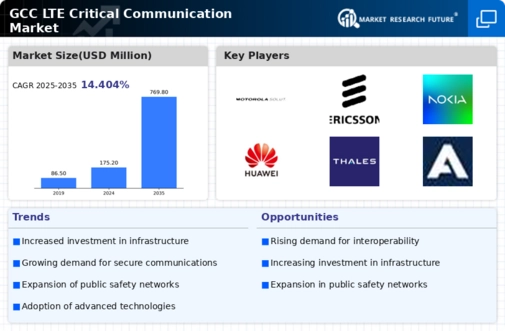Increased Focus on Cybersecurity
As The LTE Critical-Communication Market evolves, the focus on cybersecurity has become increasingly paramount. With the rise in cyber threats targeting communication networks, stakeholders are prioritizing the implementation of robust security measures to protect sensitive information. In the GCC, the cybersecurity market is projected to grow by 20% annually, reflecting the urgent need for secure communication channels. This heightened emphasis on cybersecurity is likely to drive investments in advanced encryption technologies and secure communication protocols, ensuring that critical communication remains intact during emergencies. Consequently, the lte critical-communication market is adapting to these challenges by integrating security features into its offerings, thereby enhancing trust and reliability among users.
Growing Public-Private Partnerships
The lte critical-communication market is witnessing a trend towards increased public-private partnerships, which are essential for fostering innovation and improving service delivery. In the GCC, collaboration between government entities and private sector companies is becoming more prevalent, as both parties recognize the benefits of shared resources and expertise. These partnerships are expected to facilitate the development of cutting-edge communication solutions tailored to meet the specific needs of emergency services. Market forecasts indicate that such collaborations could lead to a 10% increase in market growth over the next few years. By leveraging the strengths of both sectors, The LTE Critical-Communication Market is likely to enhance its capabilities, ensuring that communication systems are not only efficient but also adaptable to evolving challenges.
Government Initiatives and Regulations
Government initiatives play a pivotal role in shaping The LTE Critical-Communication Market. In the GCC, regulatory bodies are actively promoting the adoption of advanced communication technologies to enhance public safety and emergency response. For instance, the implementation of national frameworks aimed at standardizing communication protocols is expected to facilitate interoperability among various agencies. This regulatory push is likely to lead to an increase in market investments, with projections indicating a growth rate of around 12% annually over the next five years. Such initiatives not only foster collaboration among different sectors but also ensure that communication systems are resilient and capable of meeting the demands of modern emergencies, thereby driving the lte critical-communication market forward.
Rising Demand for Reliable Communication
The lte critical-communication market is experiencing a notable surge in demand for reliable communication solutions across various sectors, particularly in emergency services and public safety. This demand is driven by the need for uninterrupted connectivity during critical situations, where traditional communication methods may fail. In the GCC region, investments in enhancing communication infrastructure are projected to reach approximately $1.5 billion by 2026, reflecting a commitment to improving emergency response capabilities. The increasing frequency of natural disasters and security threats further emphasizes the necessity for robust communication systems. As a result, stakeholders in The LTE Critical-Communication Market are focusing on developing solutions that ensure seamless communication, thereby enhancing operational efficiency and safety in critical scenarios.
Technological Advancements in Communication
Technological advancements are significantly influencing The LTE Critical-Communication Market, particularly in the GCC region. Innovations such as 5G technology, artificial intelligence, and the Internet of Things (IoT) are being integrated into communication systems to enhance their efficiency and reliability. The introduction of 5G is expected to revolutionize critical communication by providing higher data speeds and lower latency, which are essential for real-time decision-making in emergencies. Market analysts suggest that the adoption of these technologies could lead to a market growth of approximately 15% by 2027. As organizations seek to leverage these advancements, the lte critical-communication market is likely to witness a transformation in how critical information is transmitted and processed, ultimately improving response times and operational effectiveness.

















Leave a Comment